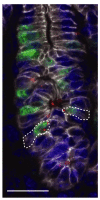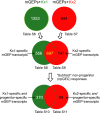Helicobacter pylori evolution during progression from chronic atrophic gastritis to gastric cancer and its impact on gastric stem cells
- PMID: 18332421
- PMCID: PMC2393758
- DOI: 10.1073/pnas.0800668105
Helicobacter pylori evolution during progression from chronic atrophic gastritis to gastric cancer and its impact on gastric stem cells
Abstract
We have characterized the adaptations of Helicobacter pylori to a rarely captured event in the evolution of its impact on host biology-the transition from chronic atrophic gastritis (ChAG) to gastric adenocarcinoma-and defined the impact of these adaptations on an intriguing but poorly characterized interaction between this bacterium and gastric epithelial stem cells. Bacterial isolates were obtained from a single human host colonized with a single dominant strain before and after his progression from ChAG to gastric adenocarcinoma during a 4-year interval. Draft genome assemblies were generated from two isolates, one ChAG-associated, the other cancer-associated. The cancer-associated strain was less fit in a gnotobiotic transgenic mouse model of human ChAG and better able to establish itself within a mouse gastric epithelial progenitor-derived cell line (mGEP) that supports bacterial attachment. GeneChip-based comparisons of the transcriptomes of mGEPs and a control mouse gastric epithelial cell line revealed that, upon infection, the cancer-associated strain regulates expression of GEP-associated signaling and metabolic pathways, and tumor suppressor genes associated with development of gastric cancer in humans, in a manner distinct from the ChAG-associated isolate. The effects on GEP metabolic pathways, some of which were confirmed in gnotobiotic mice, together with observed changes in the bacterial transcriptome are predicted to support aspects of an endosymbiosis between this microbe and gastric stem cells. These results provide insights about how H. pylori may adapt to and influence stem cell biology and how its intracellular residency could contribute to gastric tumorigenesis.
Conflict of interest statement
The authors declare no conflict of interest.
Figures



References
-
- Mitchell HM, et al. A low rate of re-infection following effective therapy against Helicobacter pylori in a developing nation (China). Gastroenterology. 1998;114:256–261. - PubMed
-
- Ohata H, et al. Progression of chronic atrophic gastritis associated with Helicobacter pylori infection increases risk of gastric cancer. Int J Cancer. 2004;109:138–143. - PubMed
-
- Syder AJ, et al. Helicobacter pylori attaches to NeuAc alpha 2,3Gal beta 1,4 glycoconjugates produced in the stomach of transgenic mice lacking parietal cells. Mol Cell. 1999;3:263–274. - PubMed
-
- Necchi V, et al. Intracellular, intercellular, and stromal invasion of gastric mucosa, preneoplastic lesions, and cancer by Helicobacter pylori. Gastroenterology. 2007;132:1009–1023. - PubMed
Publication types
MeSH terms
Associated data
- Actions
- Actions
- Actions
- Actions
- Actions
- Actions
Grants and funding
LinkOut - more resources
Full Text Sources
Other Literature Sources
Medical
Molecular Biology Databases

